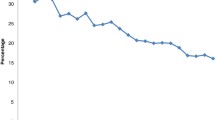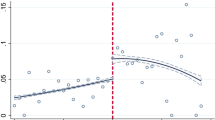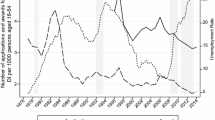Abstract
This paper uses Social Security earnings records linked to data from the Health and Retirement Study to examine the labor market behavior of rejected and accepted disability applicants prior to their application. We find that rejected applicants have substantially lower earnings and labor force participation rates during the decade prior to application than beneficiaries. Also, we find some evidence of a divergence between these groups, with rejected applicants leaving the labor force at a faster rate than beneficiaries as their application date approaches. One interpretation of these results is that the disability screening process on average separates those who are at least partially motivated by adverse economic circumstances when applying for disability benefits from other applicants.


Similar content being viewed by others
Notes
The 1984 reforms represent a classic tradeoff between Type I and Type II error. The reform lowered Type I error, the likelihood of rejecting applicants who are truly disabled at the expense of Type II error, the likelihood of accepting applicants who should not qualify.
For example, even if DI induces able-bodied people to apply for benefits, it does not necessarily imply that these people would remain in the labor force absent DI.
Another important benefit to disability recipients is medical insurance. DI recipients are automatically enrolled in Medicare after being in the program for 2 years. SSI recipients are generally enrolled in Medicaid immediately.
In 2006, the Federal Benefit Rate was $603 for individuals and $904 for couples.
See Bound and Burkhauser (1999) for a review of the literature on government disability programs.
While Bound (and most other studies) focuses on male applicants, Chen and van der Klaauw include both male and female applicants in their analysis.
They also look at the health characteristics of their sample. However, for the most part, their health information is self-reported with the disability application.
Approximately 85% of the overall HRS sample consented to this matching.
Also, another 145 have applications prior to 1992, but are excluded from the sample because the exact year of application is not observed.
Note that all earnings are in 1999 dollars.
Recall that Bound’s sample spans the 1970s, whereas Chen and van der Klaauw use data for the 1990s and data from von Wachter et al. (Forthcoming) span from 1978 to 2004.
By contrast, 57% of those without disability applications reporting being in the labor force. By 1996, the primary respondent from each household is between age 55 and 65, so a number of people in this group are retired.
Again, those with any labor earnings are considered in the labor force.
A simpler solution would be to look separately at SSI and DI applicants, but the HRS often does not distinguish between applications to the two programs (or if applications were filed for both programs).
A similar analysis was also tried keeping only those with $10,000 or more in earnings for the seven through 10 years prior to application. This analysis yielded similar results.
References
Autor D, Duggan M (2003) The rise in the disability rolls and the decline in unemployment. Q J Econ 118(1):157–206
Autor D, Duggan M (2006) The growth in the social security disability rolls: a fiscal crisis unfolding. J Econ Perspect 20(3):71–94
Benitez-Silva H, Buchinsky M, Chan HM, Rust J, Sheidvasser S (1999) An empirical analysis of the social security disability application, appeal and award process. Labour Econ 6:147–178
Black D, Daniel K, Sanders S (2002) The impact of economic conditions on participation in disability programs: evidence from the coal boom and bus. Am Econ Rev 92(1):27–50
Bound J (1989) The health and earnings of rejected disability applicants. Am Econ Rev 79:482–503
Bound J (1991) The health and earnings of rejected disability applicants: reply. Am Econ Rev 81:1427–1434
Bound J, Burkhauser R (1999) The economic analysis of transfer programs targeted on people with disabilities. Handb Labor Econ 3:3417–3528
Brooks A (2007) SSI Annual Statistical Report, 2006. Social Security Administration: Division of SSI Statistics and Analysis, Office of Research, Evaluation, and Statistics, Office of Policy
Chen S, van der Klaauw W (2008) The effect of disability insurance on labor supply of older individuals in the 1990s. J Econometrics 142(2):757–784
Duggan M, Imberman S (2008) Why are the DI rolls skyrocketing? In: David Cutler, David Wise (eds) Health at older ages: the causes and consequences of declining disability among the elderly. University of Chicago Press, Chicago
Gruber J, Kubik J (1997) Disability insurance rejection rates and the labor supply of older workers. J Public Econ 64:1–23
Kreider B, Riphahn R (1999) Explaining applications to the U.S. Disability program: a semi-parametric approach. J Hum Resour 35:82–115
Lahiri K, Vaughan DR, Wixon B (1995) Modeling SSA’s sequential disability determination process using matched SIPP data. Soc Secur Bull 58:3–42
Nagi Saad (1969) Disability and rehabilitation: legal, clinical and self-concepts and measurement. Ohio State University Press, Columbus
Parsons D (1991) The health and earnings of rejected disability insurance applicants: comment. Am Econ Rev 81:1419–26
Smith RT, Lilienfeld AM (1971) The social security disability program: an evaluation study. Social Security Administration, Office of Research and Statistics, Research Report No. 39
Social Security Administration (2006) Annual statistical supplement to the Social Security Bulletin. Office of Policy, Office of Research, Evaluation, and Statistics
von Wachter T, Song J, Manchester J (Forthcoming) Trends in employment and earnings of allowed and rejected applicants to the social security disability insurance program. American Economic Review
Author information
Authors and Affiliations
Corresponding author
Additional information
We thank Dan Black and Jan Ondrich for helpful comments. This research was supported, in part, by the Center for Retirement Research at Boston College pursuant to a grant from the U.S. Social Security Administration funded as part of the Retirement Research Consortium.
Rights and permissions
About this article
Cite this article
Giertz, S.H., Kubik, J.D. The Disability Screening Process and the Labor Market Behavior of Accepted and Rejected Applicants: Evidence from the Health and Retirement Study. J Labor Res 32, 237–253 (2011). https://doi.org/10.1007/s12122-011-9110-0
Published:
Issue Date:
DOI: https://doi.org/10.1007/s12122-011-9110-0




